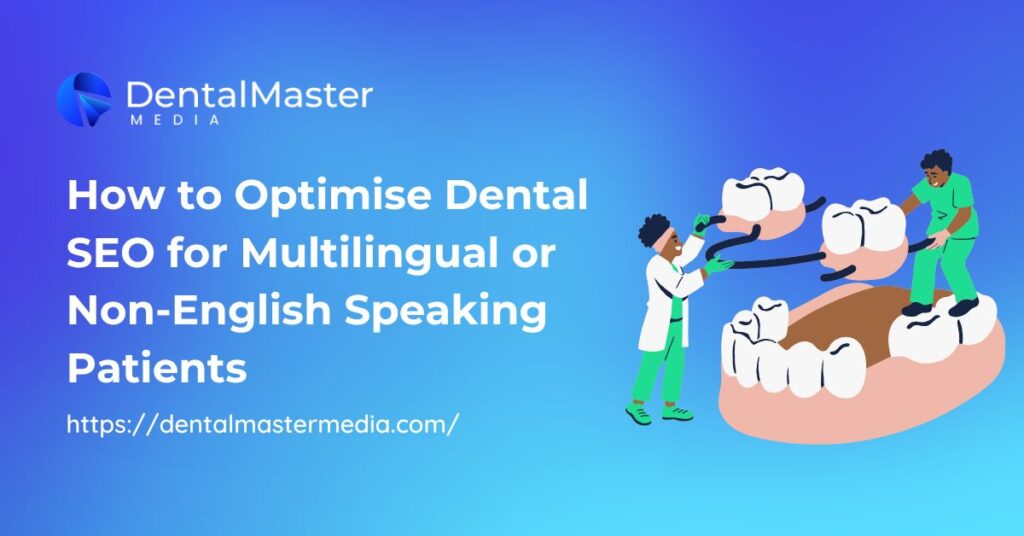Picture this: someone has a toothache and needs help. They search online, but the websites they find are all in English—and they can’t understand them.
They give up and stop looking. Now imagine that same website had information in Spanish, Chinese, or Arabic. That same person might have booked an appointment.
Helping non-English speaking patients find and understand your clinic online is not only helpful—it’s smart.
With many families speaking other languages at home, it’s important to make your dental website easy to understand for everyone. That’s where multilingual Dental SEO comes in.
Let’s break it down in a simple way so your clinic can get noticed and trusted by more people.
Why Multilingual SEO Matters for Dental Clinics
Reaching a Wider Audience
Many cities and suburbs now have people from all over the world. In Australia, more than 20% of homes speak a language other than English. If your website is only in English, you might be missing out on a big group of potential patients.
By adding languages like Mandarin, Hindi, or Arabic, your website becomes helpful to more families.
Working with a dental SEO company can make this process easier by guiding you through proper setup and content. And when people feel understood, they are more likely to trust you and visit your clinic.
Building Trust and Comfort
When people see a website in their native language, they feel more at ease. It shows you care. It makes the whole experience—booking an appointment, learning about services, understanding prices—feel simpler and friendlier.
Even small changes, like adding a translated FAQ section, can make a big difference.
Steps to Optimise Your Dental Site for Multilingual SEO
Do Proper Language Research
Start by looking at who visits your website now. Use free tools like Google Analytics. See what countries and languages are common.
If many users come from Vietnamese-speaking homes, that’s a clear sign you should offer Vietnamese translations.
Also, look at your local area. Government stats and local schools can show what languages are common nearby.
Translate the Right Way
Don’t rely on auto-translators. They often get medical terms wrong. A poorly translated site can confuse people or even turn them away.
Hire professionals who speak the language fluently and understand your clinic’s message. It’s worth the effort.
Use Hreflang Tags Correctly
These are small pieces of code that tell search engines which language version of a page to show. If someone in Australia searches in Mandarin, the “zh-au” page should show up instead of the English one.
This helps search engines like Google send people to the right version of your site.
Make Your Site Easy to Switch Languages
Place a clear language switch button at the top right of your site. Use flag icons or simple labels like “Español” or “中文”.
Don’t hide the option. If it’s hard to find, people might leave the site instead of exploring more.
Optimise Each Language Page for SEO
Keyword Research in Every Language
Don’t just translate your English keywords. Instead, find what people in that language actually search for. Tools like Google Keyword Planner can help.
Example: People may search “dental implants” in English but “implantes dentales” in Spanish.
Unique Meta Titles and Descriptions
Every language page needs its own meta title and meta description. These are the short pieces of text that appear in Google search results.
Using the right keywords helps your pages rank better and get more clicks.
A provider of dental SEO services can help you write these in a way that matches what people are searching for in each language.
Use Alt Text for Images in Each Language
Alt text helps people who use screen readers. It also gives search engines clues about what’s on your site.
Use simple, clear language in each version.
Local SEO for Multilingual Patients
Set Up Local Listings in Different Languages
Your Google Business Profile is key. Use translated service names, business hours, and photos. While Google doesn’t allow full translation inside the main listing, you can add posts and Q&As in other languages.
This helps your clinic show up when people search in their native language.
Get Reviews from Non-English Speaking Patients
Encourage happy patients to leave reviews in their first language. This can improve your credibility with other families who speak the same language and support your overall Dental Practice Marketing strategy.
If you get a review in another language, try to reply in the same one. It shows respect and builds loyalty.
Don’t Forget Mobile Experience
Make Language Options Mobile Friendly
On phones, every click matters. Language switchers should be easy to tap. They should not hide behind menus or small icons.
Test your site on both Apple and Android phones.
Speed and Accessibility Matter
A slow site makes people leave. This is true for every language version. Compress your images, use clean design, and keep menus simple.
Use fonts that are easy to read, even in languages with special characters.
Promote Multilingual Content
Share Content on Social Media in Multiple Languages
If you have a Facebook or Instagram page, post dental tips in more than one language. Short posts with photos or videos work best for SEO and audience engagement.
When making videos, add subtitles in different languages. This boosts both views and trust, improving your social media SEO and helping more people find your content.
Blog in More Than One Language
Add blogs in the top two or three languages your patients speak. Write about common dental problems, brushing tips, or how check-ups work.
Google loves helpful blogs. So do patients. This kind of content also boosts your visibility online.
Conclusion
Helping more people understand and trust your dental clinic starts with your website. Adding other languages and doing proper Dental SEO makes it easier for more families to find you.
Start with one or two popular languages in your area. Use professional translators, set up the right tags, and research the best keywords.
Your effort pays off with more calls, more appointments, and more smiles.
If you’re ready to grow, work with Dental SEO Services that offer multilingual support. They can handle the technical parts while you focus on your patients.
Want to reach more families in your community? Talk to a Dental SEO expert today and take the first step.

Suraj Rana is the owner of Dental Master Media and a leading expert in SEO for dental practices. With a passion for dental marketing, he has successfully helped numerous dental clinics climb the search engine ranks. Suraj’s expertise makes him a go-to resource for effective, results-driven dental marketing.

